
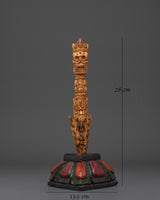
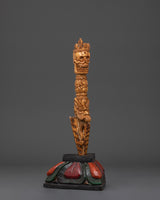

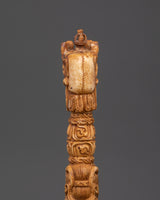

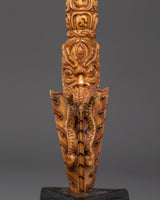
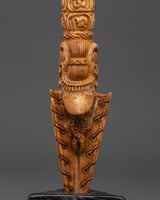
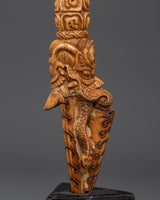
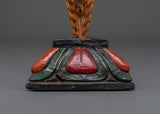
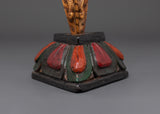
Handcrafted Tibetan Phurba | Unique Spiritual Tool for Healing

100% AUTHENTIC

HANDMADE

FREE SHIPPING
Handcrafted Tibetan Phurba | Ancient Design and Powerful Spiritual Significance
--------------------------------------------
Size: 28cm (Height) x 13.5cm (Width)
Weight: 0.27kg
Materials: Wooden base, Buffalo Bone, Acrylic Color
--------------------------------------------
About The Ritual Item :
Embrace the magic of Tibetan spirituality with our Handcrafted Tibetan Phurba, a remarkable work of artistry. Standing at 28cm tall and featuring elaborate carvings, this ritual tool embodies the profound connection between the material and spiritual realms. The Phurba is a historical Tibetan item thought to have the ability to cleanse negative energy and protect its bearer. Its design combines powerful themes, including a crowned skull at the top, which depicts the triumph over death and the cycle of rebirth. The dagger's base, decorated in brilliant colors, represents the marriage of spiritual balance and worldly energies.
The Tibetan Phurba is painstakingly created, with every detail delicately carved to reflect its rich spiritual legacy. The upper skull design is carved to symbolize the transcendence of death, while the lower area depicts complex animal and mythical creature depictions. These symbols are thought to represent protection, healing, and spiritual alignment. This ceremonial dagger is more than just a decorative piece; it is also an effective tool for meditation, rituals, and spiritual activities, allowing you to connect more deeply with the energy inside and around you. This Phurba, whether displayed on your altar or used in religious rites, exudes enormous symbolic power and beauty.
Introduction To The Phurba :
The ceremonial dagger (Sanskrit: Kila; Tibetan: phurba) is essential for expelling evil and is considered particularly effective in neutralizing the forces obstructing Tantric Buddhist practice. It has ancient origins, first appearing in the Indian Rig Veda as the core blade of the vajra used by Indra to destroy the primordial cosmic snake Vritra. Kila, derived from Sanskrit, was most likely associated with Vedic sacrifices. Meditation on the Vajrakila Tantra, an early Indian scripture first promoted in Tibet in the eighth century by Padmasambhava, one of the founding teachers of Tibetan Buddhism, is used to invoke the three-headed Vajrakila Buddha.
How to Set Up Your Buddhist Shrine?
Find a clean, quiet, and uncluttered spot.
Please set up an altar table and cover it with an altar cloth that calls to you.
Place your sacred item (statue, thangka, or a picture of Buddha) at the center.





















